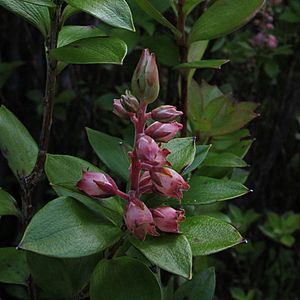Archeria (plant) facts for kids
Quick facts for kids Archeria |
|
|---|---|
 |
|
| Archeria racemosa on Little Barrier Island, New Zealand | |
| Scientific classification |
|
| Kingdom: | Plantae |
| Clade: | Tracheophytes |
| Clade: | Angiosperms |
| Clade: | Eudicots |
| Clade: | Asterids |
| Order: | Ericales |
| Family: | Ericaceae |
| Subfamily: | Styphelioideae |
| Tribe: | Archerieae Crayn & Quinn |
| Genus: | Archeria Hook.f. |
Archeria is a small group of shrubs that belong to the plant family Ericaceae. This family also includes well-known plants like heather and blueberry. There are six different types, or species, of Archeria. All of them grow naturally only in southern Australasia, which includes Australia and New Zealand.
Four of these species are found only in Tasmania, an island state of Australia. The other two species are found only in New Zealand. Even though these plants are not used for food or other important products, people who study nature have always admired them. This is because they have pretty, small, tube-shaped flowers and interesting leaves with a net-like pattern of veins.
Contents
What are the Archeria Species?
There are six known species of Archeria:
- Archeria comberi – Found in Tasmania.
- Archeria eriocarpa – Found in Tasmania.
- Archeria hirtella – Found in Tasmania.
- Archeria racemosa – Found in New Zealand.
- Archeria serpyllifolia – Found in Tasmania.
- Archeria traversii – Found in New Zealand.
Where Do Archeria Plants Grow?
Archeria plants are found in different parts of Tasmania, including the south, west, north, and central areas. However, they are mostly missing from the eastern side of the island.
In New Zealand, the two species grow in very separate areas. A. racemosa is found only in the northern part of the North Island. A. traversii is found in scattered spots across the South Island and Stewart Island.
How Do Archeria Plants Live?
Like many plants in the Ericaceae family, Archeria species usually grow in acidic soils. They can be found from low-lying areas all the way up to mountain slopes. Some species, like A. comberi and A. hirtella, can even grow in very high, cold areas close to the sub-alpine zone.
Most Archeria species grow in shrublands and forests. However, A. comberi is a bit different. It prefers to grow in heaths, sedgelands (areas with grass-like plants), and wetlands.
What Do Archeria Plants Look Like?
Archeria plants are all shrubs that stand up on their own. They have dark-colored bark.
Leaves
The leaves of Archeria plants are simple and grow one after another along the stem. They are smooth and can have edges that are either completely smooth or slightly toothed. A special feature of Archeria leaves is their unique net-like pattern of veins. This pattern is not found in other plants in their specific group.
Flowers and Fruits
The flowers of Archeria grow on small stalks. They can appear in short clusters at the ends of branches or as single flowers growing from the leaf joints. The flowers usually have five parts. After the flowers bloom, they produce capsules that open up to release many small seeds.
How Did Archeria Evolve?
Scientists have studied the physical features of Archeria plants and their DNA. This research shows that Archeria belongs to a specific group within the Ericaceae family. It is considered unique enough to have its own special group, called the Archerieae.
Who Named Archeria?
The genus Archeria was named in 1844 by a famous botanist named Joseph Dalton Hooker. He named it after William Archer, who was a botanist from Tasmania in the 1800s.
See also
 In Spanish: Archeria para niños
In Spanish: Archeria para niños

